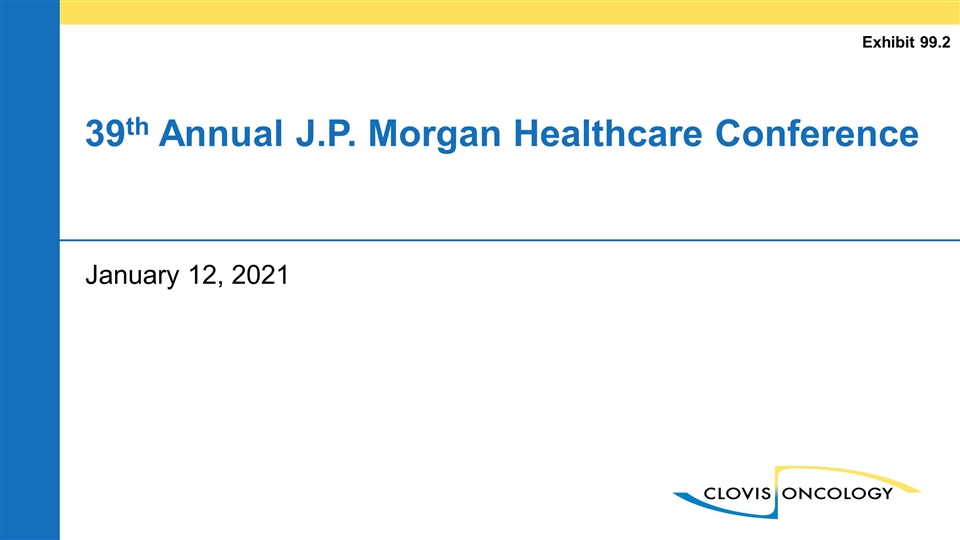
39th Annual J.P. Morgan Healthcare Conference January 12, 2021 Exhibit 99.2
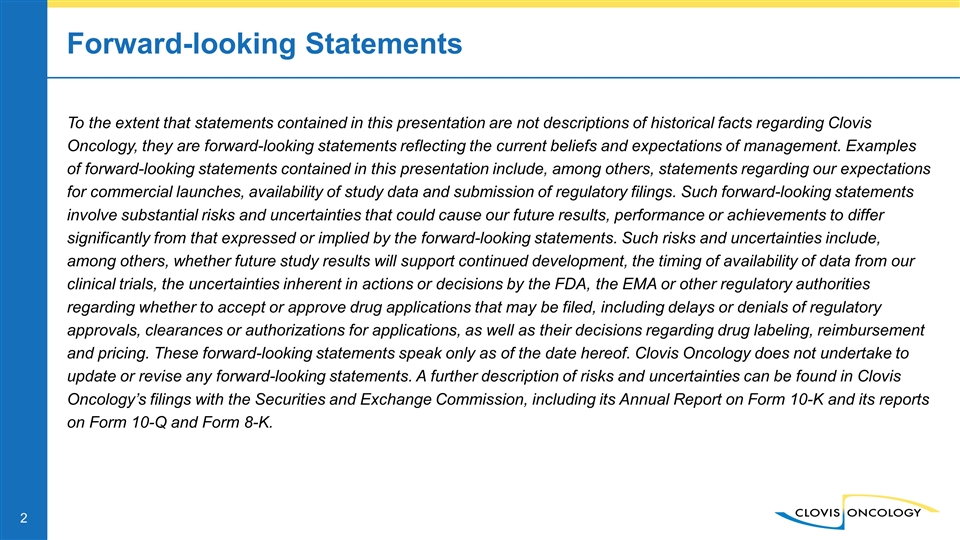
To the extent that statements contained in this presentation are not descriptions of historical facts regarding Clovis Oncology, they are forward-looking statements reflecting the current beliefs and expectations of management. Examples of forward-looking statements contained in this presentation include, among others, statements regarding our expectations for commercial launches, availability of study data and submission of regulatory filings. Such forward-looking statements involve substantial risks and uncertainties that could cause our future results, performance or achievements to differ significantly from that expressed or implied by the forward-looking statements. Such risks and uncertainties include, among others, whether future study results will support continued development, the timing of availability of data from our clinical trials, the uncertainties inherent in actions or decisions by the FDA, the EMA or other regulatory authorities regarding whether to accept or approve drug applications that may be filed, including delays or denials of regulatory approvals, clearances or authorizations for applications, as well as their decisions regarding drug labeling, reimbursement and pricing. These forward-looking statements speak only as of the date hereof. Clovis Oncology does not undertake to update or revise any forward-looking statements. A further description of risks and uncertainties can be found in Clovis Oncology’s filings with the Securities and Exchange Commission, including its Annual Report on Form 10-K and its reports on Form 10-Q and Form 8-K. Forward-looking Statements
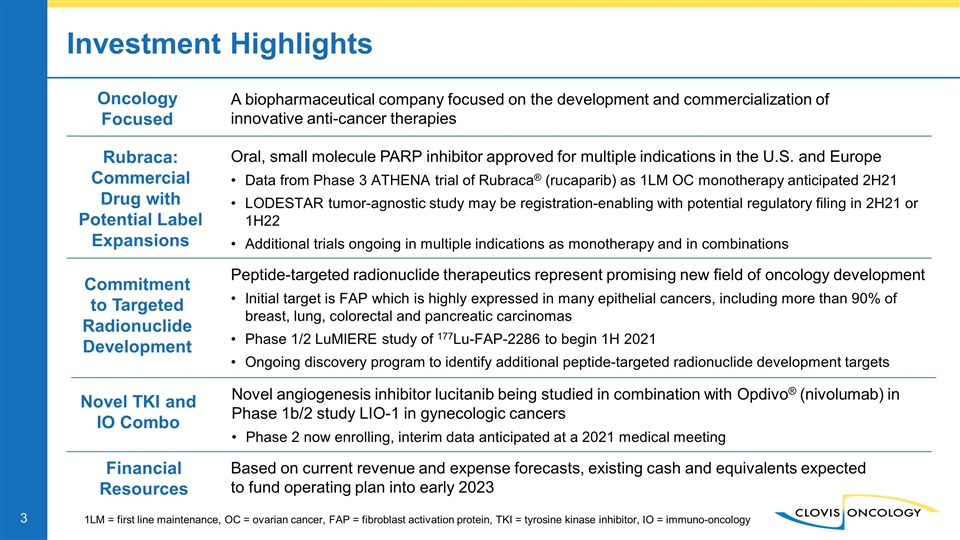
Investment Highlights Oncology Focused A biopharmaceutical company focused on the development and commercialization of innovative anti-cancer therapies Financial Resources Based on current revenue and expense forecasts, existing cash and equivalents expected to fund operating plan into early 2023 Rubraca: Commercial Drug with Potential Label Expansions Oral, small molecule PARP inhibitor approved for multiple indications in the U.S. and Europe Data from Phase 3 ATHENA trial of Rubraca® (rucaparib) as 1LM OC monotherapy anticipated 2H21 LODESTAR tumor-agnostic study may be registration-enabling with potential regulatory filing in 2H21 or 1H22 Additional trials ongoing in multiple indications as monotherapy and in combinations Commitment to Targeted Radionuclide Development Peptide-targeted radionuclide therapeutics represent promising new field of oncology development Initial target is FAP which is highly expressed in many epithelial cancers, including more than 90% of breast, lung, colorectal and pancreatic carcinomas Phase 1/2 LuMIERE study of 177Lu-FAP-2286 to begin 1H 2021 Ongoing discovery program to identify additional peptide-targeted radionuclide development targets Novel TKI and IO Combo Novel angiogenesis inhibitor lucitanib being studied in combination with Opdivo® (nivolumab) in Phase 1b/2 study LIO-1 in gynecologic cancers Phase 2 now enrolling, interim data anticipated at a 2021 medical meeting 1LM = first line maintenance, OC = ovarian cancer, FAP = fibroblast activation protein, TKI = tyrosine kinase inhibitor, IO = immuno‑oncology
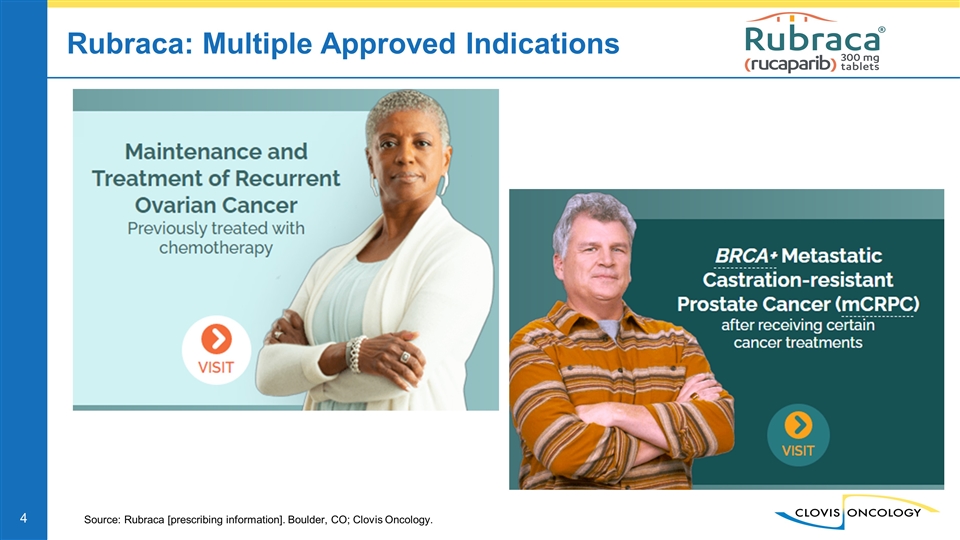
Rubraca: Multiple Approved Indications Source: Rubraca [prescribing information]. Boulder, CO; Clovis Oncology.
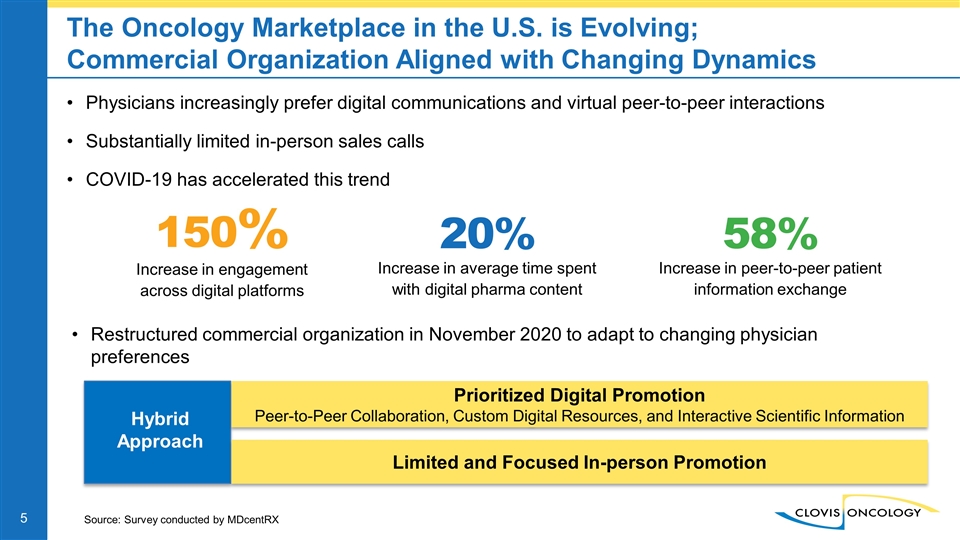
The Oncology Marketplace in the U.S. is Evolving; Commercial Organization Aligned with Changing Dynamics Physicians increasingly prefer digital communications and virtual peer-to-peer interactions Substantially limited in-person sales calls COVID-19 has accelerated this trend 150% Increase in engagement across digital platforms 20% Increase in average time spent with digital pharma content 58% Increase in peer-to-peer patient information exchange Restructured commercial organization in November 2020 to adapt to changing physician preferences Hybrid Approach Prioritized Digital Promotion Peer-to-Peer Collaboration, Custom Digital Resources, and Interactive Scientific Information Limited and Focused In-person Promotion Source: Survey conducted by MDcentRX
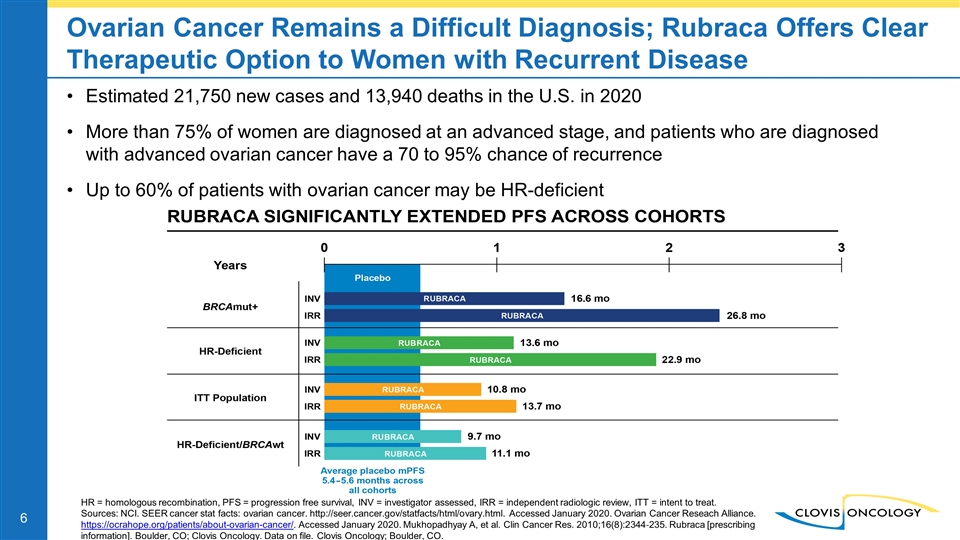
Ovarian Cancer Remains a Difficult Diagnosis; Rubraca Offers Clear Therapeutic Option to Women with Recurrent Disease Estimated 21,750 new cases and 13,940 deaths in the U.S. in 2020 More than 75% of women are diagnosed at an advanced stage, and patients who are diagnosed with advanced ovarian cancer have a 70 to 95% chance of recurrence Up to 60% of patients with ovarian cancer may be HR-deficient HR = homologous recombination, PFS = progression free survival, INV = investigator assessed, IRR = independent radiologic review, ITT = intent to treat. Sources: NCI. SEER cancer stat facts: ovarian cancer. http://seer.cancer.gov/statfacts/html/ovary.html. Accessed January 2020. Ovarian Cancer Reseach Alliance. https://ocrahope.org/patients/about-ovarian-cancer/. Accessed January 2020. Mukhopadhyay A, et al. Clin Cancer Res. 2010;16(8):2344‐235. Rubraca [prescribing information]. Boulder, CO; Clovis Oncology. Data on file. Clovis Oncology; Boulder, CO.
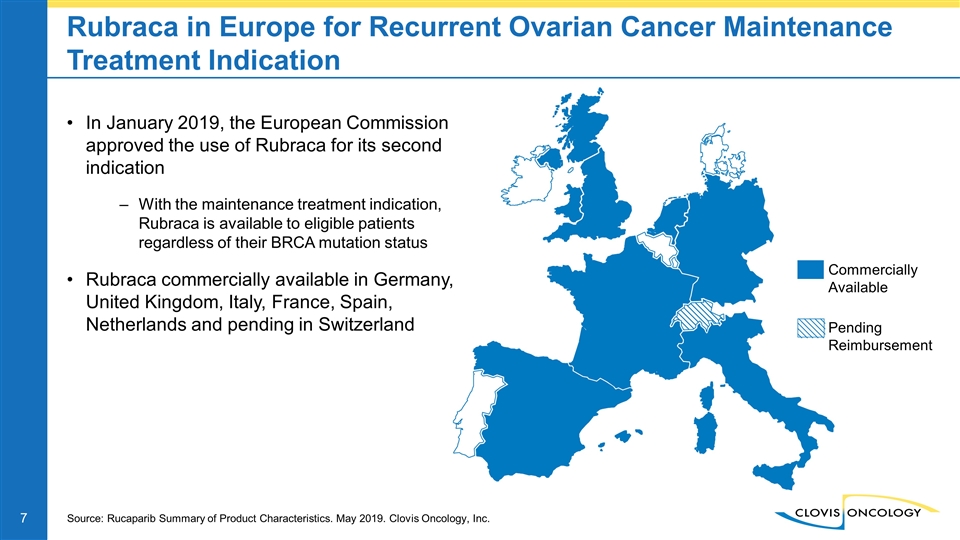
Rubraca in Europe for Recurrent Ovarian Cancer Maintenance Treatment Indication In January 2019, the European Commission approved the use of Rubraca for its second indication With the maintenance treatment indication, Rubraca is available to eligible patients regardless of their BRCA mutation status Rubraca commercially available in Germany, United Kingdom, Italy, France, Spain, Netherlands and pending in Switzerland Commercially Available Pending Reimbursement Source: Rucaparib Summary of Product Characteristics. May 2019. Clovis Oncology, Inc.
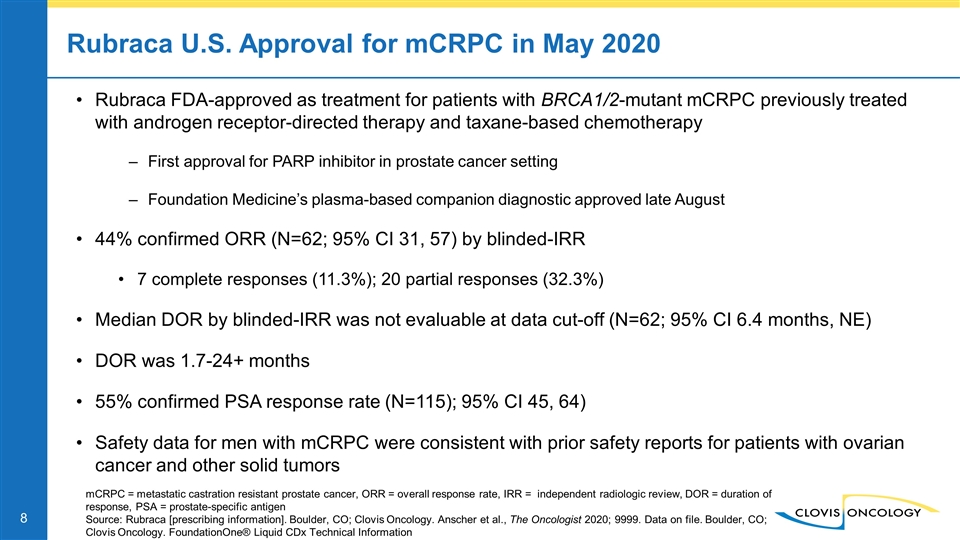
Rubraca U.S. Approval for mCRPC in May 2020 Rubraca FDA-approved as treatment for patients with BRCA1/2-mutant mCRPC previously treated with androgen receptor-directed therapy and taxane-based chemotherapy First approval for PARP inhibitor in prostate cancer setting Foundation Medicine’s plasma-based companion diagnostic approved late August 44% confirmed ORR (N=62; 95% CI 31, 57) by blinded-IRR 7 complete responses (11.3%); 20 partial responses (32.3%) Median DOR by blinded-IRR was not evaluable at data cut-off (N=62; 95% CI 6.4 months, NE) DOR was 1.7-24+ months 55% confirmed PSA response rate (N=115); 95% CI 45, 64) Safety data for men with mCRPC were consistent with prior safety reports for patients with ovarian cancer and other solid tumors mCRPC = metastatic castration resistant prostate cancer, ORR = overall response rate, IRR = independent radiologic review, DOR = duration of response, PSA = prostate-specific antigen Source: Rubraca [prescribing information]. Boulder, CO; Clovis Oncology. Anscher et al., The Oncologist 2020; 9999. Data on file. Boulder, CO; Clovis Oncology. FoundationOne® Liquid CDx Technical Information
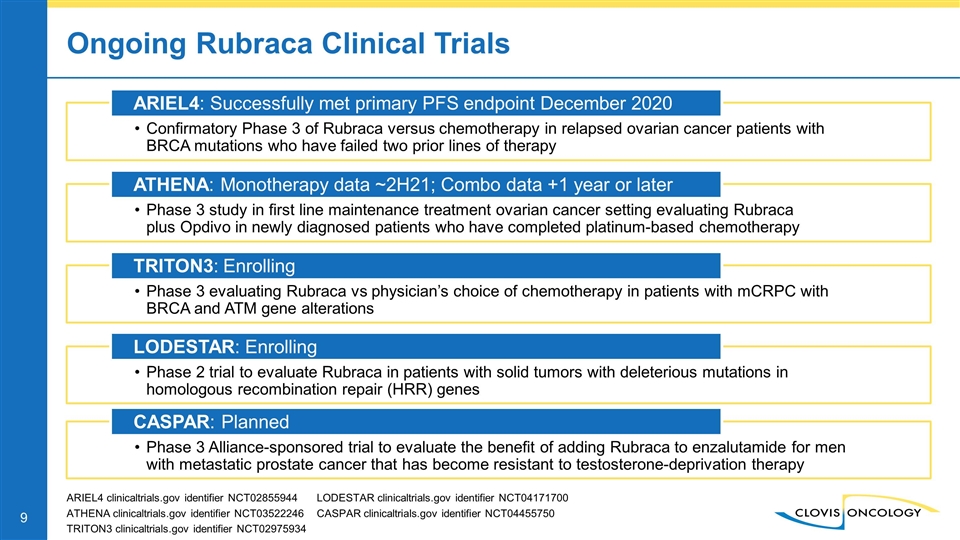
Ongoing Rubraca Clinical Trials Confirmatory Phase 3 of Rubraca versus chemotherapy in relapsed ovarian cancer patients with BRCA mutations who have failed two prior lines of therapy ARIEL4: Successfully met primary PFS endpoint December 2020 Phase 3 study in first line maintenance treatment ovarian cancer setting evaluating Rubraca plus Opdivo in newly diagnosed patients who have completed platinum-based chemotherapy ATHENA: Monotherapy data ~2H21; Combo data +1 year or later Phase 3 evaluating Rubraca vs physician’s choice of chemotherapy in patients with mCRPC with BRCA and ATM gene alterations TRITON3: Enrolling Phase 2 trial to evaluate Rubraca in patients with solid tumors with deleterious mutations in homologous recombination repair (HRR) genes LODESTAR: Enrolling ARIEL4 clinicaltrials.gov identifier NCT02855944 ATHENA clinicaltrials.gov identifier NCT03522246 TRITON3 clinicaltrials.gov identifier NCT02975934 Phase 3 Alliance-sponsored trial to evaluate the benefit of adding Rubraca to enzalutamide for men with metastatic prostate cancer that has become resistant to testosterone-deprivation therapy CASPAR: Planned LODESTAR clinicaltrials.gov identifier NCT04171700 CASPAR clinicaltrials.gov identifier NCT04455750
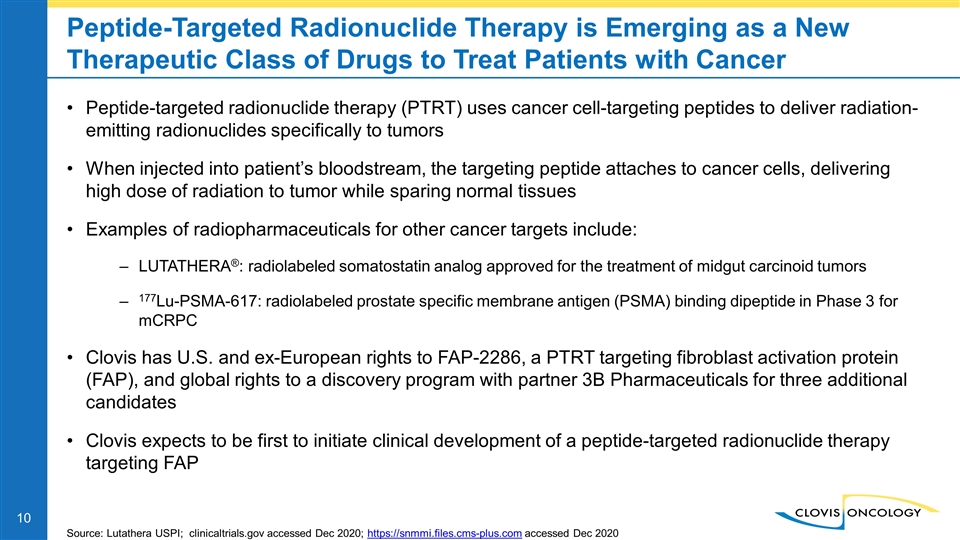
Peptide-Targeted Radionuclide Therapy is Emerging as a New Therapeutic Class of Drugs to Treat Patients with Cancer Peptide-targeted radionuclide therapy (PTRT) uses cancer cell-targeting peptides to deliver radiation-emitting radionuclides specifically to tumors When injected into patient’s bloodstream, the targeting peptide attaches to cancer cells, delivering high dose of radiation to tumor while sparing normal tissues Examples of radiopharmaceuticals for other cancer targets include: LUTATHERA®: radiolabeled somatostatin analog approved for the treatment of midgut carcinoid tumors 177Lu-PSMA-617: radiolabeled prostate specific membrane antigen (PSMA) binding dipeptide in Phase 3 for mCRPC Clovis has U.S. and ex-European rights to FAP-2286, a PTRT targeting fibroblast activation protein (FAP), and global rights to a discovery program with partner 3B Pharmaceuticals for three additional candidates Clovis expects to be first to initiate clinical development of a peptide-targeted radionuclide therapy targeting FAP Source: Lutathera USPI; clinicaltrials.gov accessed Dec 2020; https://snmmi.files.cms-plus.com accessed Dec 2020
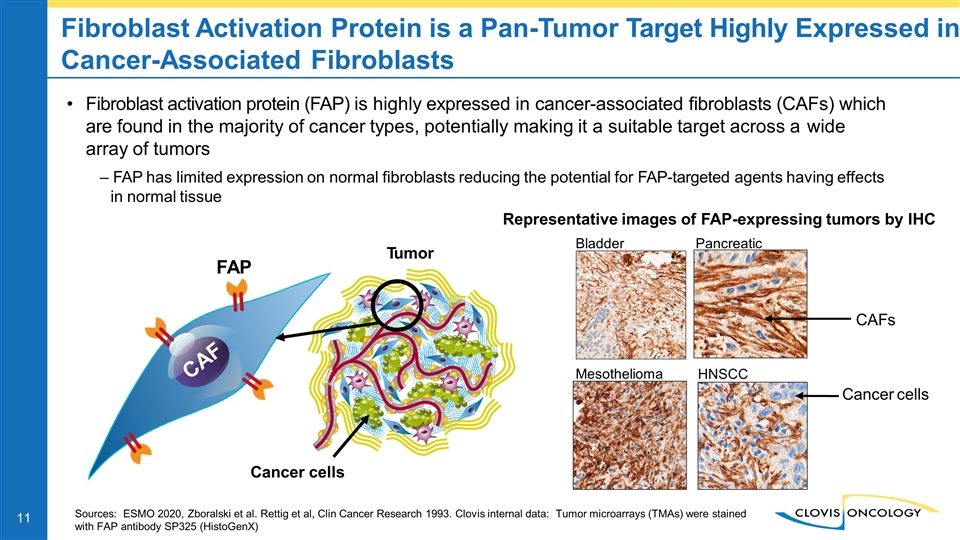
Fibroblast Activation Protein is a Pan-Tumor Target Highly Expressed in Cancer-Associated Fibroblasts Fibroblast activation protein (FAP) is highly expressed in cancer-associated fibroblasts (CAFs) which are found in the majority of cancer types, potentially making it a suitable target across a wide array of tumors – FAP has limited expression on normal fibroblasts reducing the potential for FAP-targeted agents having effects in normal tissue Sources: ESMO 2020, Zboralski et al. Rettig et al, Clin Cancer Research 1993. Clovis internal data: Tumor microarrays (TMAs) were stained with FAP antibody SP325 (HistoGenX) Representative images of FAP-expressing tumors by IHC Cancer cells Tumor FAP Cancer cells Blood flow CAF CAFs HNSCC Pancreatic Mesothelioma Bladder
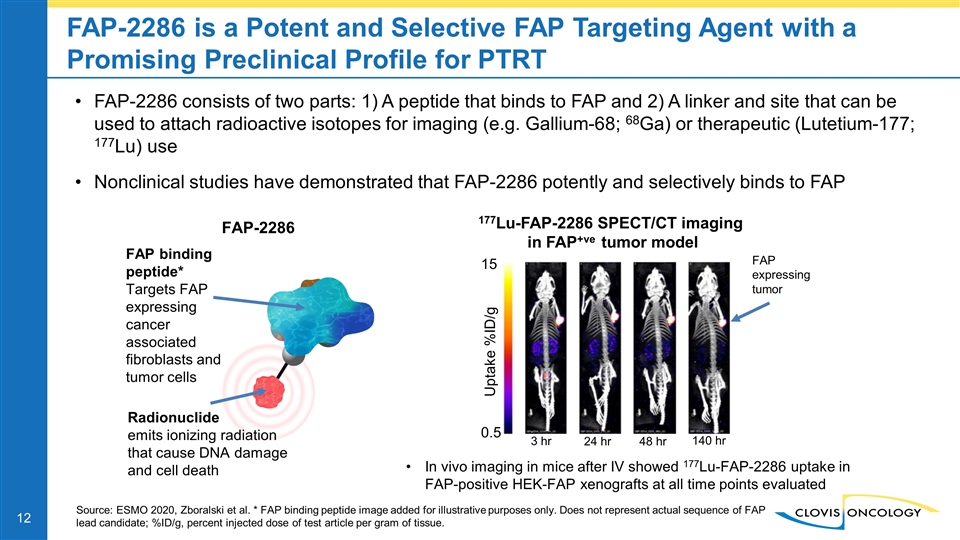
FAP-2286 is a Potent and Selective FAP Targeting Agent with a Promising Preclinical Profile for PTRT FAP-2286 consists of two parts: 1) A peptide that binds to FAP and 2) A linker and site that can be used to attach radioactive isotopes for imaging (e.g. Gallium-68; 68Ga) or therapeutic (Lutetium-177; 177Lu) use Nonclinical studies have demonstrated that FAP-2286 potently and selectively binds to FAP FAP-2286 FAP binding peptide* Targets FAP expressing cancer associated fibroblasts and tumor cells Radionuclide emits ionizing radiation that cause DNA damage and cell death Source: ESMO 2020, Zboralski et al. * FAP binding peptide image added for illustrative purposes only. Does not represent actual sequence of FAP lead candidate; %ID/g, percent injected dose of test article per gram of tissue. In vivo imaging in mice after IV showed 177Lu-FAP-2286 uptake in FAP-positive HEK-FAP xenografts at all time points evaluated 177Lu-FAP-2286 SPECT/CT imaging in FAP+ve tumor model 3 hr 24 hr 48 hr 140 hr Uptake %ID/g 0.5 15 FAP expressing tumor
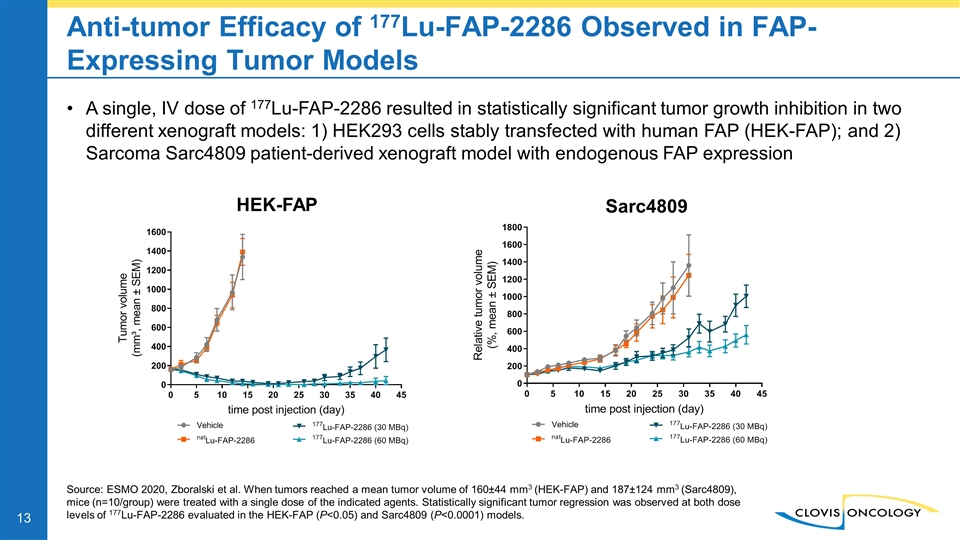
Anti-tumor Efficacy of 177Lu-FAP-2286 Observed in FAP-Expressing Tumor Models A single, IV dose of 177Lu-FAP-2286 resulted in statistically significant tumor growth inhibition in two different xenograft models: 1) HEK293 cells stably transfected with human FAP (HEK-FAP); and 2) Sarcoma Sarc4809 patient-derived xenograft model with endogenous FAP expression Source: ESMO 2020, Zboralski et al. When tumors reached a mean tumor volume of 160±44 mm3 (HEK-FAP) and 187±124 mm3 (Sarc4809), mice (n=10/group) were treated with a single dose of the indicated agents. Statistically significant tumor regression was observed at both dose levels of 177Lu-FAP-2286 evaluated in the HEK-FAP (P<0.05) and Sarc4809 (P<0.0001) models. HEK-FAP Sarc4809
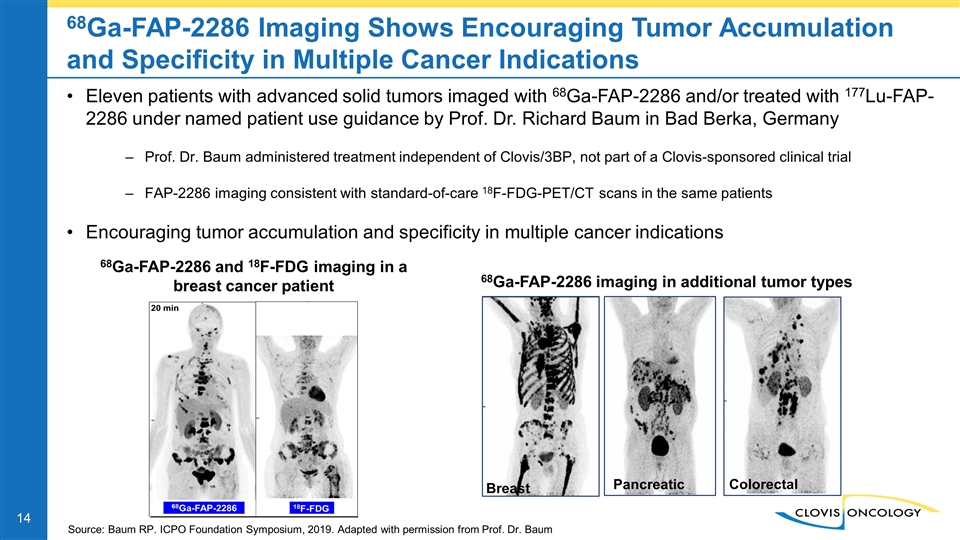
68Ga-FAP-2286 Imaging Shows Encouraging Tumor Accumulation and Specificity in Multiple Cancer Indications Eleven patients with advanced solid tumors imaged with 68Ga-FAP-2286 and/or treated with 177Lu-FAP-2286 under named patient use guidance by Prof. Dr. Richard Baum in Bad Berka, Germany Prof. Dr. Baum administered treatment independent of Clovis/3BP, not part of a Clovis-sponsored clinical trial FAP-2286 imaging consistent with standard-of-care 18F-FDG-PET/CT scans in the same patients Encouraging tumor accumulation and specificity in multiple cancer indications 68Ga-FAP-2286 imaging in additional tumor types Breast Pancreatic Colorectal Source: Baum RP. ICPO Foundation Symposium, 2019. Adapted with permission from Prof. Dr. Baum 68Ga-FAP-2286 and 18F-FDG imaging in a breast cancer patient
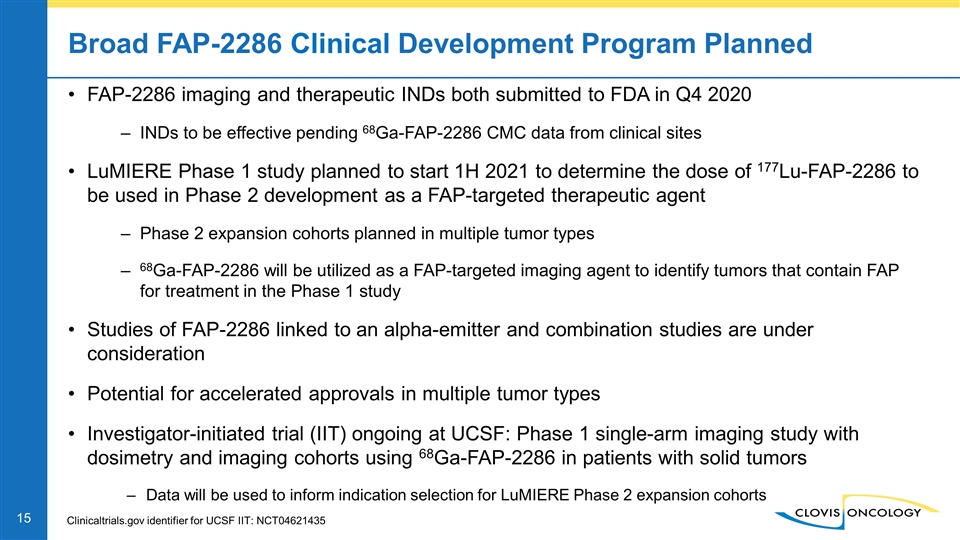
Broad FAP-2286 Clinical Development Program Planned FAP-2286 imaging and therapeutic INDs both submitted to FDA in Q4 2020 INDs to be effective pending 68Ga-FAP-2286 CMC data from clinical sites LuMIERE Phase 1 study planned to start 1H 2021 to determine the dose of 177Lu-FAP-2286 to be used in Phase 2 development as a FAP-targeted therapeutic agent Phase 2 expansion cohorts planned in multiple tumor types 68Ga-FAP-2286 will be utilized as a FAP-targeted imaging agent to identify tumors that contain FAP for treatment in the Phase 1 study Studies of FAP-2286 linked to an alpha-emitter and combination studies are under consideration Potential for accelerated approvals in multiple tumor types Investigator-initiated trial (IIT) ongoing at UCSF: Phase 1 single-arm imaging study with dosimetry and imaging cohorts using 68Ga-FAP-2286 in patients with solid tumors Data will be used to inform indication selection for LuMIERE Phase 2 expansion cohorts Clinicaltrials.gov identifier for UCSF IIT: NCT04621435
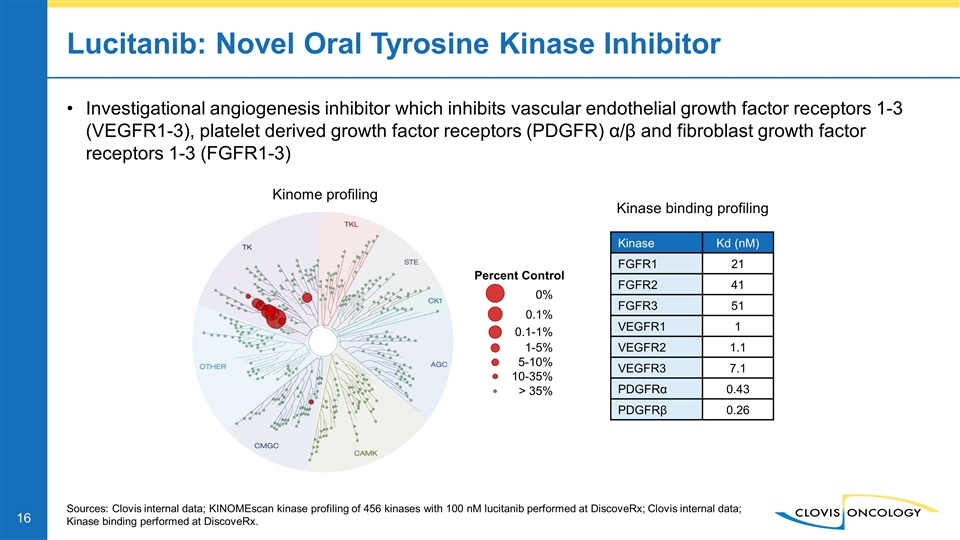
Lucitanib: Novel Oral Tyrosine Kinase Inhibitor Investigational angiogenesis inhibitor which inhibits vascular endothelial growth factor receptors 1-3 (VEGFR1-3), platelet derived growth factor receptors (PDGFR) α/β and fibroblast growth factor receptors 1-3 (FGFR1-3) Kinase Kd (nM) FGFR1 21 FGFR2 41 FGFR3 51 VEGFR1 1 VEGFR2 1.1 VEGFR3 7.1 PDGFRα 0.43 PDGFRβ 0.26 Kinome profiling Kinase binding profiling Sources: Clovis internal data; KINOMEscan kinase profiling of 456 kinases with 100 nM lucitanib performed at DiscoveRx; Clovis internal data; Kinase binding performed at DiscoveRx. Percent Control 0% 0.1% 0.1-1% 1-5% 5-10% 10-35% > 35%
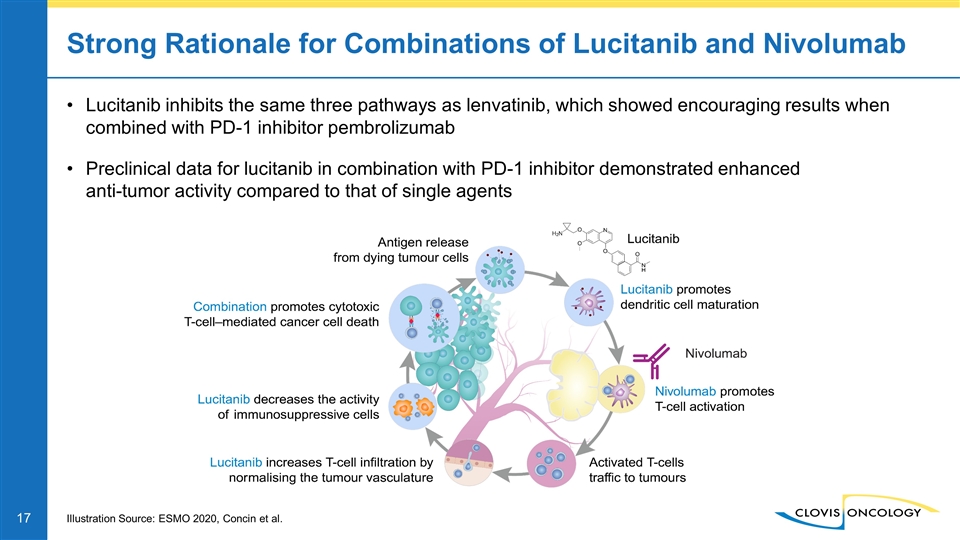
Strong Rationale for Combinations of Lucitanib and Nivolumab Lucitanib inhibits the same three pathways as lenvatinib, which showed encouraging results when combined with PD-1 inhibitor pembrolizumab Preclinical data for lucitanib in combination with PD-1 inhibitor demonstrated enhanced anti-tumor activity compared to that of single agents Illustration Source: ESMO 2020, Concin et al.
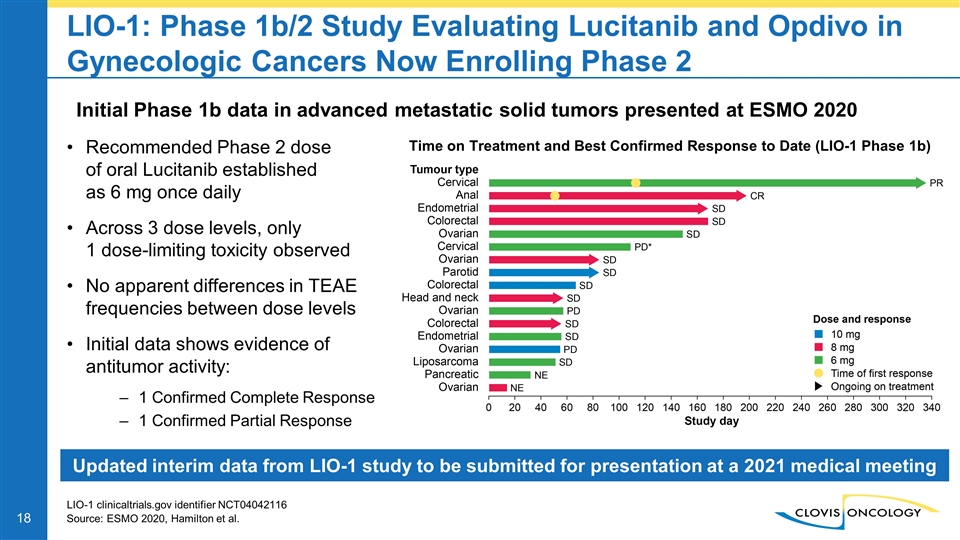
LIO-1: Phase 1b/2 Study Evaluating Lucitanib and Opdivo in Gynecologic Cancers Now Enrolling Phase 2 Recommended Phase 2 dose of oral Lucitanib established as 6 mg once daily Across 3 dose levels, only 1 dose-limiting toxicity observed No apparent differences in TEAE frequencies between dose levels Initial data shows evidence of antitumor activity: 1 Confirmed Complete Response 1 Confirmed Partial Response Updated interim data from LIO-1 study to be submitted for presentation at a 2021 medical meeting Time on Treatment and Best Confirmed Response to Date (LIO-1 Phase 1b) Source: ESMO 2020, Hamilton et al. LIO-1 clinicaltrials.gov identifier NCT04042116 Initial Phase 1b data in advanced metastatic solid tumors presented at ESMO 2020
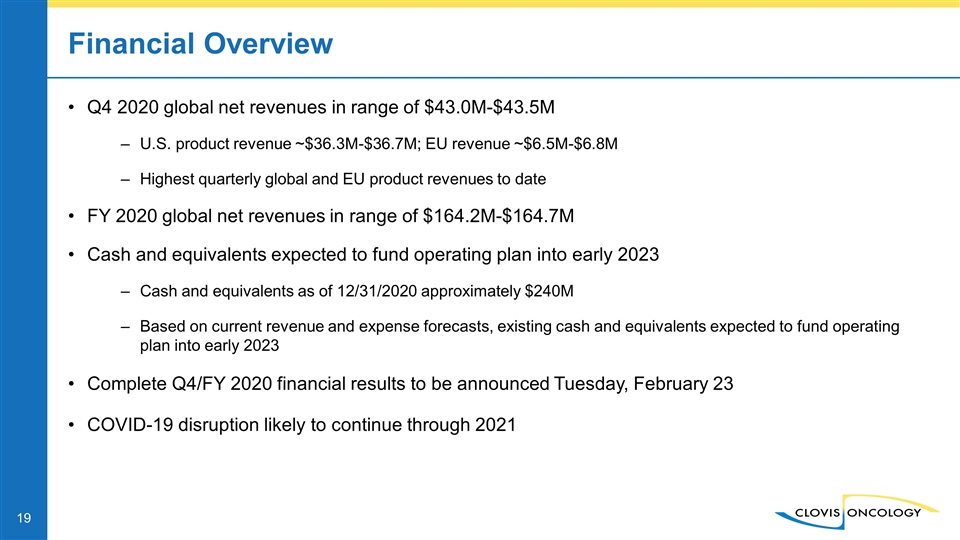
Financial Overview Q4 2020 global net revenues in range of $43.0M-$43.5M U.S. product revenue ~$36.3M-$36.7M; EU revenue ~$6.5M-$6.8M Highest quarterly global and EU product revenues to date FY 2020 global net revenues in range of $164.2M-$164.7M Cash and equivalents expected to fund operating plan into early 2023 Cash and equivalents as of 12/31/2020 approximately $240M Based on current revenue and expense forecasts, existing cash and equivalents expected to fund operating plan into early 2023 Complete Q4/FY 2020 financial results to be announced Tuesday, February 23 COVID-19 disruption likely to continue through 2021
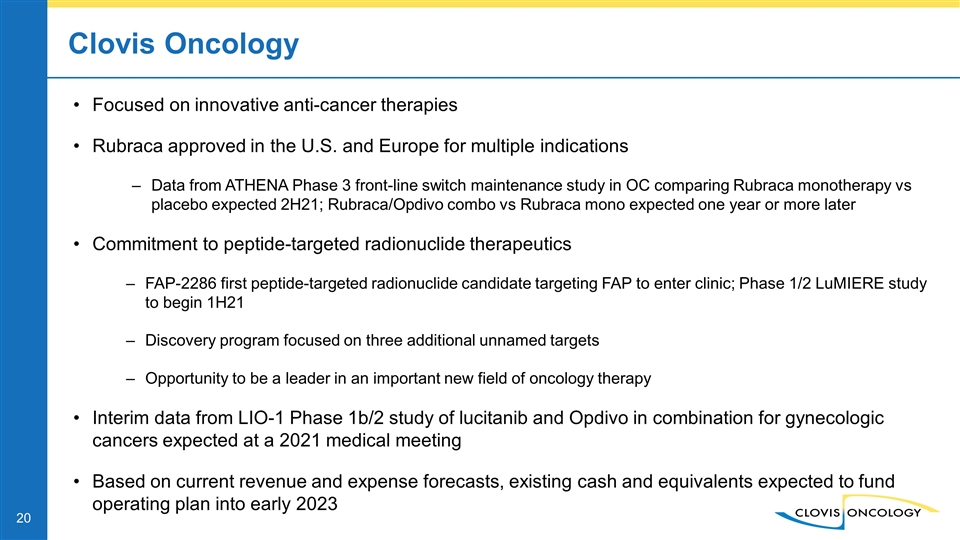
Clovis Oncology Focused on innovative anti-cancer therapies Rubraca approved in the U.S. and Europe for multiple indications Data from ATHENA Phase 3 front-line switch maintenance study in OC comparing Rubraca monotherapy vs placebo expected 2H21; Rubraca/Opdivo combo vs Rubraca mono expected one year or more later Commitment to peptide-targeted radionuclide therapeutics FAP-2286 first peptide-targeted radionuclide candidate targeting FAP to enter clinic; Phase 1/2 LuMIERE study to begin 1H21 Discovery program focused on three additional unnamed targets Opportunity to be a leader in an important new field of oncology therapy Interim data from LIO-1 Phase 1b/2 study of lucitanib and Opdivo in combination for gynecologic cancers expected at a 2021 medical meeting Based on current revenue and expense forecasts, existing cash and equivalents expected to fund operating plan into early 2023



















